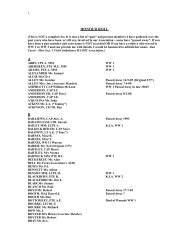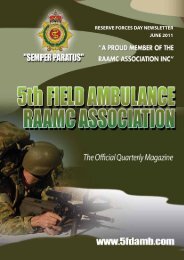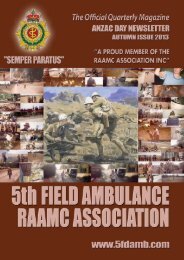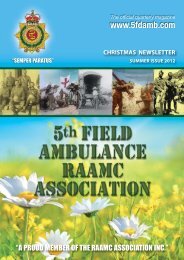2010 Paulatim Magazine - RAAMC Association
2010 Paulatim Magazine - RAAMC Association
2010 Paulatim Magazine - RAAMC Association
Create successful ePaper yourself
Turn your PDF publications into a flip-book with our unique Google optimized e-Paper software.
Considering the Deployable Role for<br />
Army Physical Training Instructors<br />
This year 15 PTIs have been deployed, have just returned or are<br />
preparing for operations. These PTIs have been deployed on all manner<br />
of operations from Afghanistan to PNG and yet not one was deployed<br />
with a medical unit or in the primary role of rehabilitation. These PTIs<br />
provided support by delivering the five mandated services. They are<br />
adaptive and are able to concentrate their efforts at any time on the<br />
main focus and requirements of the unit.<br />
PTIs have long concentrated on developing skills, enhancing physical<br />
and emotional resilience, maintaining soldier wellbeing and inculcating<br />
a sense of teamwork and Army ethos amongst the participants in<br />
physical activities. The diagram, shown below, highlights the services<br />
that are provided by Army PTIs. However, it would appear that whilst<br />
other Corps and units have embraced all that a PTI can deliver, <strong>RAAMC</strong><br />
focus and attitude towards PTIs remains exclusively in the rehabilitation<br />
environment. The capabilities of PTIs are interconnected and at<br />
different times the focus may change so that the primary services can<br />
be delivered to meet the commander’s intent.<br />
• leadership in injury prevention through:<br />
°<br />
°<br />
°<br />
°<br />
scientifically based and progressive training regimes,<br />
training and assurance strategies to monitor the conduct of<br />
sport and physical training activities.<br />
developing physical and mental resilience in soldiers, and<br />
analysis of injury data and trends.<br />
LWD 1-2 Combat Health Support 2009 states that physical activity is<br />
important for health and well being and LWP 1-2-3 Health Support<br />
Battalion 2005 identifies that preventative health can be achieved<br />
through health education and promotion, injury prevention and<br />
Physical Training. The later also states that PTIs provide limited rehab<br />
services and that PTIs contribute to the rehab team. This reinforces<br />
that PTIs provide physical conditioning within the rehabilitation<br />
environment. PTIs are taught in the rehabilitation module at the<br />
ADFPTS that they do not treat the injury. PTIs are trained to provide<br />
physical conditioning to maintain non injured sights and deliver<br />
progressive training to allow personnel to return to the work<br />
environment.<br />
LWP 1-2-3 states that PTIs assists in developing capability to endure<br />
physical and emotional stress and it is reasonable to expect that<br />
personnel working in the health fraternity on operations would benefit<br />
equally from a physical training program that has been adopted for the<br />
operational environment to ensure maintenance in the deployable<br />
force.<br />
These defined and mandated roles enhance combat power by:<br />
• physical training to compliment foundation warfighting and skills<br />
associated with performing the role of an Australian Soldier,<br />
• morale support activities to sustain cognitive capabilities, positive<br />
attitudes and encourage sound lifestyle behaviours;<br />
• supervise, provide instruction and governance over the complex<br />
military self defence environment;<br />
• physical conditioning, skill development and leadership in the<br />
physical rehabilitation and mental health environment; and<br />
<strong>RAAMC</strong> policy documents clearly articulate the role of PTIs and physical<br />
training. PTIs can contribute significantly not only to the well being of<br />
personnel receiving care from the health units, but also to the members<br />
of the unit. PTIs are able to provide services that will promote health,<br />
enhance capability and contribute to the health status of any<br />
deployable force.<br />
PTIs provide physical conditioning in the rehabilitation environment and<br />
I hope that personnel within the Corps will start to think in this vein. I<br />
encourage those who are considering manning for <strong>RAAMC</strong> operational<br />
commitments in the future to consider all that PTIs can deliver and not<br />
just to think of them strictly as a rehabilitation option.<br />
By: WO1 Clayton Baker<br />
7 6 P A U L AT I M – M A GAZINE O F T HE R OYA L A U S T R A L I A N A R M Y M E DICAL C O R P S – 2 0 1 0










